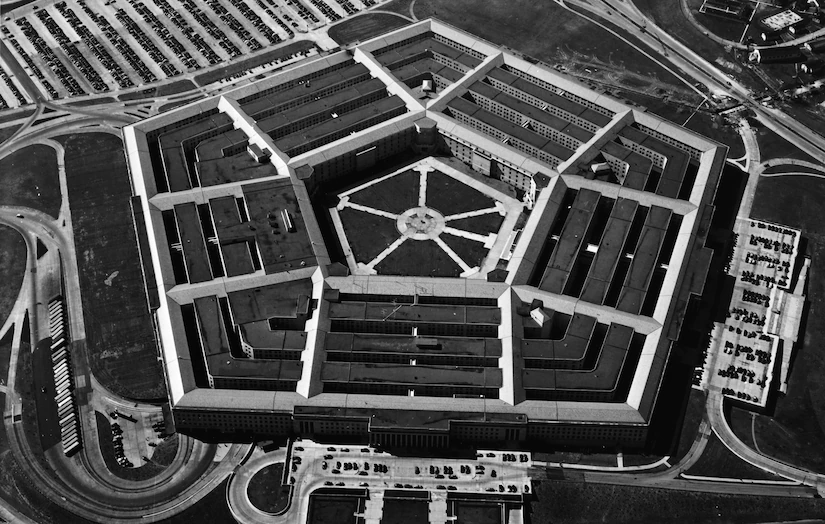
the Pentagon, designed originally for a site bordered by five roads, was named for its geometric shape
Source: US Department of Defense, 10 Things You Probably Didn't Know About the Pentagon

the Pentagon, designed originally for a site bordered by five roads, was named for its geometric shape
Source: US Department of Defense, 10 Things You Probably Didn't Know About the Pentagon
Virginia could have been called Ossomocomuck. That was the Algonquan term for the Outer Banks area, where the first Engish colonists reached North America in 1584. When the English asked the Native Americans to identify the name of the place, there was a miscommunication. The response was "Wingandacon," but that was a comment on the style of dress of the colonists. The colonists thought the name of the area was Wingandacon, but that an Algonquian comment on how the English wore "fancy clothes." Later clarification of the miscommunication revealed the area was known to the local residents as Ossomocomuck.
Sir Walter Ralegh chose to name his North Carolina settlement after Queen Elizabeth I. She granted him favors, including the right to establish a colony in North America even though that risked exacerbating the conflict with Spain - which considered Virginia to be part of "Florida."
The Spanish named the eastern part of North America for the day Ponce de Leon landed on the peninsula north of Cuba in 1513. He arrived on Easter Sunday, or "Pascua de Flores" (Feat of Flowers). "Mexico" was applied by the Spanish just to the lands on the western edge of the Gulf of Mexico. The Aztecs who lived there were called the Mexica in the Nahuatl language.
Being a female ruler of England triggered prejudice by people who assumed that only men could be responsible leaders. Queen Elizabeth I mimimized her display of her gender; she never married and never gave birth.
Choosing a spouse for the ruler of England would create a political alliance, and the queen never found the right opportunity to create a more-powerful England without generating an undesired response from its enemies. Spain, France, and significant interest groups within England would be affected if the queen married someone from a rival group. As an unmarried woman all her life, she was presumed to be a virgin. Ralegh honored her by calling his colony "Virginia."1
A sure way to distinguish a tourist in Staunton is to hear them pronounce the city's name as STAWN-ton. If someone refers to the town of Matchipongo on the Eastern Shore as MAY-shi-pong-oh rather than match-uh-PUNG-oh, they were not "Shoreborn." Locals on the Eastern Shore know to pronounce Onley as OWN-lee, Onancock as uh-NAN-kok, Chincoteague as SHINK-uh-tig or SHINK-uh-teeg, Quinby as KWIM-bee, and Wachapreague as WATCH-uh-prig.
If a newly-arrived teacher in Fairfax County refers to the POT-oh-mack River rather than the Poh-TOE-mack or Poh-TOE-muck, the teacher's "I know stuff, listen to me" credibility with the students will be affected. However, John Smith originally spelled the river as the Patawomeke, suggesting a pair of syllables have been dropped. The modern, "correct" pronunciation may be inconsistent with the 1607 pronunciation in the Algonquian language.2
Place names not only distinguish one place from another, they also reflect the heritage of Virginia.
Most of the names used by Native Americans before European colonization have been lost, but some remain. The English interpretation of those names may be incorrect, reflecting cultural misunderstandings and confusion. In the case of Shenandoah, an advertising executive created a complete myth after the Civil War that the word meant "daughter of the stars."3

French maps in 1650 showed the Powhatan rather than the James River
Source: Library of Congress, Amérique septentrionale (by Nicolas Sanson, 1650)
Some of the remaining places names inherited from the Native Americans include:
The most common name for a city with at least 20,000 residents is a tie between "Springfield" and "Columbus." Each have four cities using that name. "Richmond" is tied for second place. In addition to the capital of Virginia, there are cities with at least 20,000 residents named Richmond in California, Indiana, and Kentucky.9
According to the US Postal Service:10
The US Board on Geographic Names, the Federal organization responsible for approving names on maps produced by Federal agencies, was established by President Benjamin Harrison in 1890. As the population grew between 1850-1890, the number of Post Offices increased from 18,417 to 62,401. Mail delivery was complicated by the use of the same name for separate places. In 1891, the Post Office Department officially decided to use names as chosen by that board.
President Theodore Roosevelt directed that names be standardized, and in over a century only five place names with apostrophes have been authorized - Martha's Vineyard (MA), Ike's Point (NJ), John E's Pond (RI), Carlos Elmer's Joshua View (AZ), and Clark's Mountain (OR). In 1933, the Post Office adopted 12 principles for assigning place names to post offices, one of which was to "avoid the possessive."
As a result of the policy, no Virginia location has an apostrophe in its name on Federal maps. Tysons Corner (now just "Tysons") in Northern Virginia has never included an apostrophe.11
Perhaps the place name mis-pronounced most often is "Staunton." The city was named for Lady Rebecca Staunton, the wife of Governor Gooch. Locals pronounce the town "Stan-ton," but many visitors say "Stawn-ton" - until they are corrected. It is unclear how her name was pronounced in her lifetime; her family and friends may have used Stawn-ton.12
Other place names that often confuse visitors include Botetourt County. The jurisdiction, named after Governor Botetourt, uses the Englich pronunciation of "Bot-a-tot." The City of Buena Vista is pronounced "Bew-na Viss-tuh."13

on Federal maps, there has never been an apostrophe in Tysons Corner/Tysons
Source: US Geological Survey (USGS), Falls Church, VA 1:24,000 topographic quadrangle (1965)